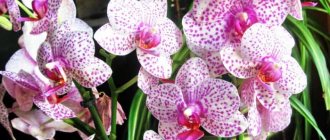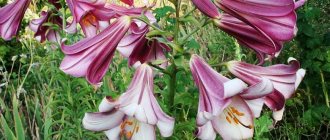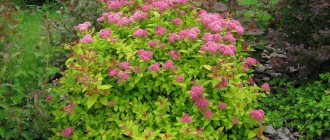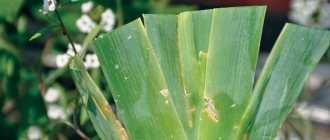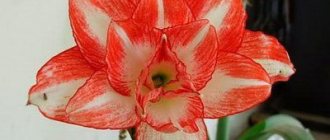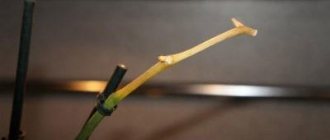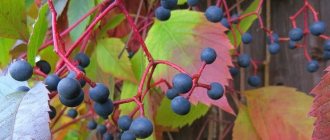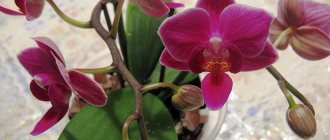How to prune an orchid? The plant needs to be pruned on time to ensure long and abundant flowering and to take care of the health of the flower. In this article we will examine in detail in what cases it is necessary to trim an orchid and how to do it correctly. We will also raise questions about the baby: when to separate it and how to do it.
Note! If necessary, you need to prune an orchid of any variety, including cymbidium, vanda, phalaenopsis, etc. The principle of pruning is identical. Remember that you need to use only sharp, disinfected devices and be sure to treat the cut areas.
Which species need pruning?
When growing any variety of orchid, it may be necessary to trim the flower stalk. Different pruning methods are used in different situations and for different species.
Orchids are distinguished by the speed of appearance and abundance of flowers, the duration of bud formation:
- upon completion of flowering, an apical bud is formed, which produces new buds or lateral arrows. In such a situation, there is no need to rush into pruning. It is started if the entire peduncle has dried up or in order to put the plant into a state of dormancy. This type of flowering is observed only in phalaenopsis;
- in vanda, dendrobium, cymbidium, and cattleya, flowers appear once per season and open simultaneously. Faded parts are removed immediately after falling or drying;
- in some species of the Paphiopedilum genus, new buds may form on the flowering stem. It is better to hold off on pruning such beauties;
- There are varieties with a revolver type of flowering. Their buds open one by one over several months. It makes sense to prune them after flowering has finished.
How and when to prune depends not only on the type of flowering.
How and when to separate the baby?
How and when to separate the baby? The formation of a baby on the mother specimen is a natural process for an orchid. It looks like an adult plant, but in miniature form and mostly without flowers. However, sometimes the baby blooms directly on the mother specimen, that is, even before separation. The photo shows a clear example.
One adult plant can have several small ones at the same time. They first develop leaves, and eventually roots. The presence of roots two centimeters long is a signal that the baby can be trimmed and planted. Practice shows that it is better to plant a small plant with three to four roots of five centimeters. In this case, better survival rate is observed.
The process of separating the baby is similar to any pruning procedure. You need to take a sharp, disinfected tool (knife, garden pruners or scissors) and carefully cut, taking into account:
- Baby on a peduncle. It is cut so that one or two centimeters of the peduncle remain on both sides. The cut areas are treated with crushed activated carbon and dried for thirty minutes.
- New plant on the root (basal location). In this case, first make sure there are roots, and then separate at the place where the baby and mother specimen are connected. The cut area should be sprinkled with either ground cinnamon or crushed activated carbon.
- Baby in leaf axil. In this case, when pruning, at least one centimeter of the mother tissue is captured. The cut area must be treated immediately.
Then the baby needs to be placed in a greenhouse in a container with a small amount of substrate and comfortable conditions maintained (temperature 28-29 degrees, humidity - 90%, illumination with soft and diffused light for 12 hours), if it is very small and needs active growth.
You can also use the watering and drying method. A container is needed to accommodate the baby. Every morning, warm (5-7 degrees warmer than room temperature) settled water is poured into the container so that the roots of the baby lightly touch it. Keep the plant in this form for forty minutes, and then drain the water. The algorithm is repeated until longer roots are formed.
A large baby can be immediately planted in a pot with a substrate, which is represented by pine bark (fine fraction), particles of charcoal and sphagnum moss. You can make the soil yourself at home or purchase it at a specialty store. Do what suits you best. Further care for the baby is similar to the maintenance of an adult specimen.
Remember that pruning of any type of orchid (phalaenopsis, vanda, cymbidium, etc.) is done if necessary. It is better not to disturb the plant unnecessarily. If possible, combine pruning with the time of replanting so that the plant does not get stressed twice. If only the peduncles are cut, then replanting is not necessary. After the procedure, maintain comfortable growing conditions for the orchid so that it will delight you with abundant flowering and beauty.
Pruning is required if the peduncle...
There are several cases when pruning is recommended:
- The peduncle has completely dried out. The brown stick does not decorate the flower at all;
- The orchid bloomed many times and became a little weaker. Pruning will speed up the onset of dormancy and help it recover;
- the flowering stem withers, the plant is sick or requires replanting. After removing the wilted part, the orchid will not spend all its resources on it;
- The variety blooms only once a year.
In all other cases, it is better to wait.
Faded
Pruning is carried out on plants that produce new flower stalks from other buds on the stem after they have completely flowered. The wilted part will prevent new buds from appearing:
- draw out useful substances;
- shade the remaining parts;
- do not allow the orchid to go into a dormant period.
The pruning method also depends on the type of flower.
Important. Experienced gardeners recommend interfering as little as possible with the natural development of plants. Beautiful orchids survive well without human help. It is better to give them the opportunity to develop independently.
Stayed green
The green peduncle is cut off only in those species that produce new stems for flowering. In other varieties it is left.
Depending on the variety it is possible:
- re-blooming;
- germination of flowering rods from faded ones;
- acceleration of the beginning of a new budding cycle in varieties that do not have a pronounced resting phase, for example, in phalaenopsis and vanda.
When the flower enters the dormant phase on its own, the peduncle should be allowed to dry completely. You can determine the end of flowering by a change in the shade of the peduncle; it loses its brightness and becomes “waxy.”
Attention. Plants have a recycling mechanism. Before part of it dries out completely, it gives all the useful substances to other shoots for development. That is why you should not rush with pruning.
Brown and dry
The brown dried peduncle is cut off immediately:
- He has already given away all the useful resources.
- In nature, it would simply break off under the pressure of the wind.
- A dried stem will not look aesthetically pleasing if you do not help the flower get rid of the unnecessary part.
If there is any doubt that the recycling process has ended, you can wait a week and then prune.
Not completely dry
Sometimes it happens that only part of the pedicels dry out, but live buds remain on the shoot. In this case:
- cut off the dried part;
- treat it with a disinfectant composition;
- feed the plant.
The method is suitable only for flowers with a long flowering period or varieties that produce shoots from the peduncle.
Has dormant buds and fades little by little
In this situation, the decision is made based on the general condition of the flower and the duration of pre-flowering. You can just wait, and then the plant’s development will continue:
- The kidneys will awaken.
- These will form buds or cuttings.
- The flower will again please the eye, or will give rise to a new life.
Pruning with an indentation of one and a half to two cm above a full bud will help speed up the reproduction process. It is worth considering that this does not always lead to awakening.
Interesting. Trimmed parts of the peduncle with buds can be used for propagation. Therefore, sometimes it is better to cut off the fading part of the flower.
Trimming orchids with simple and repeated flowering
The first thing a gardener must do is to understand the flowering characteristics of a particular genus or type of orchid. They all behave differently after flowering has finished, and this information should be the basis for making a decision.
The vast majority of orchids do not bloom repeatedly on the same arrow. In such plants, after flowering, the peduncle dries out and dies. But there are also orchids that can form new buds at the top of the arrow and produce flowers. This type of flowering is called “revolving”:
| Orchids with simple flowering | Orchids with "revolving" flowering |
|
|
Trimming the faded peduncle of simple flowering orchids is just a matter of time. Some orchid growers prefer to remove it immediately, while others believe that it is better to let the arrow dry on its own. Which option to choose can be decided by the grower himself.
What to do with the peduncle of orchids prone to re-blooming depends on the type of orchid:
- Paphiopedilums with revolving flowering are not pruned after the flower fades. Many varieties of lady's slipper can bloom more than 10 times on one arrow. Therefore, pruning of the peduncle is carried out only after it begins to dry out.
- The top of the phalaenopsis can be cut off and left if there is a living bud on it. This bud, upon awakening, will produce a flower, but most often only one. How much it is needed is up to the grower to decide.
Thus, orchids with simple flowering are pruned after flowering in any case, and earlier or later depends on the beliefs of the grower. Orchids that form a continuation bud at the top are pruned according to the situation.
Important! If the orchid itself is weak, it is better to cut the faded arrow after it has completely dried. Nutrients such as nitrogen, potassium, magnesium or sulfur can easily move through plant tissues and move from dying parts to growing ones. This phenomenon is called battery recycling.
In some cases, a full-fledged shoot with several buds grows from the apical bud of the phalaenopsis. That is why many orchid growers are in no hurry to cut the arrow after flowering. But to obtain this effect, the plant needs to be provided with ideal conditions.
How to prune after flowering?
Before you start pruning, you need to prepare:
- wear clothes with sleeves and rubber gloves - plant sap can cause irritation;
- wipe the instrument with a disinfectant or boil it for several minutes;
- prepare a container for garbage or cuttings if you want to use cut parts for propagation.
Disinfection materials should be on hand.
Tools
Pruning is done with pruning shears. It is also necessary to prepare materials for treating damaged surfaces:
- You can use brilliant green, hydrogen peroxide or activated carbon as an antiseptic.
- Wax - for sealing the shoots of plants with a hollow stem.
- Alcohol or other disinfectant if you plan to trim several different orchids.
Attention! It is better not to use a knife or scissors during work. Any awkward movement and the fragile leaf plates or stem of the orchid will break.
Determining the cut point
The position of the pruning site is determined based on the purposes and reasons why parts of the orchid are removed:
- dried flower stalks are cut off almost completely, leaving 2-3 cm of the living parts of the flower;
- to cause the awakening of flowering or the formation of children, pruning is done 1-2 cm above the first full-fledged dormant bud;
- when it is necessary to shorten the peduncle and cause the growth of side shoots, cut off part of the flower, leaving two or three lower buds.
It is better to make the cut at a minimum distance from the outlet. Then more buds will appear on the branches.
Is disinfection of the cut stem necessary or not?
Disinfection is necessary when pruning green parts of plants. There are millions of microorganisms flying around us that can cause various diseases:
- bacteria;
- viruses;
- fungal spores.
They come from the street, or can remain on clothes after working with other specimens. The cut site is the gateway to any infection, so it needs to be disinfected or at least sprinkled with activated carbon to dry it.
What to do if the trunk is hollow inside
Hollow shoots are found in many orchid species. There is no need to worry about this. But after pruning, special processing will be required.
Water will enter the cavity that appears after pruning. And this will lead to the development of putrefactive processes. As they develop, they will deteriorate:
- Flower stem.
- Socket.
- Main stem.
- Roots.
The sick beauty will have to be treated. Even with good care, she can die. Therefore, the cut is sealed with soft beeswax.
Features of carrying out in varieties
- The best time for pruning is October-November, it is at this time that most orchids enter the resting phase. The main thing to remember is that orchids should not be subjected to such procedures during flowering. Otherwise, the plant may die.
- You should not cut off green flower stalks; even a drying shoot provides nutrients to the flower.
- The healing of plants must be carried out in the first half of the day, then by night it will already come to its senses.
- You need to cut off faded or diseased elements with a sharp, disinfected tool, preferably a small garden pruner. You need to wear gloves when working, as some varieties of orchids have poisonous juice.
Oncidium
Oncidium orchids are found most often in home collections. A distinctive feature of this variety is the presence of a lip on the inflorescence . It resembles a developing skirt, for which the variety is called “dancing dolls”.
Oncidium pleases with flowering, mainly in spring and autumn. There are individuals that bloom more often.
Plant height ranges from 15 cm (dwarf varieties) to 2 meters (tall). Flowers, from red-brown to yellow, are collected in brushes. The size of the peduncle is from 2 to 15 cm.
Features of cultivation
Oncidium roots do not contain chlorophyll, so it can be grown in a ceramic pot. The flower is light-loving, and if you place it on the north side, it will not bloom. Just like others, this orchid does not like direct sun . Prefers a shower with a temperature of about 40 degrees. During the formation of the peduncle, watering is completely stopped, resuming it when the arrow appears.
Below is a video about caring for the Oncidium orchid:
Cattleya
The Cattleya orchid has amazingly bright colors and original shapes, valued for the ruffled edges of its velvet petals. It has the ability to independently grow in width. Indoor representatives up to 40 cm in height.
On relatively low shoots (up to 20 cm), up to 5 flowers 12-25 cm in diameter bloom. A mature flowering plant looks like a bouquet.
Growing
Cattleya does not tolerate spraying! Watering this exotic depends on the phase of flower development:
- During the rest period it decreases, and a month before the end it stops altogether. Feeding is excluded.
- During the flowering period, watering and fertilizing are introduced gradually.
- During the growth period, the plant is watered every 3-7 days, together with complex fertilizer.
Watering is carried out using the immersion method.
We invite you to watch an informative video about growing Cattleya orchids:
Dendrobium
The Dendrobium orchid has more than 1.5 thousand species and they all differ not only in size (from a few centimeters to 2 meters) and color, but also in the shape of the flower brushes. Among the variety of species, there is one common feature - the “lip” differs in color from the main color of the flower.
The number of flowers on an arrow can reach 100 pieces, so such a weight needs support.
It is recommended to water dried roots with warm, settled water, alternating the immersion and surface methods. During the flowering phase, watering should be reduced, and during the dormant period, it should be eliminated.
Dendrobium loves fresh air, but like other Orchids it does not tolerate drafts.
Below is a video about Dendrobium orchia and its care:
When should leaves be removed?
Leaf blades of orchids are cut off in 3 cases: if the plant is sick, to stimulate flowering; if the stem of a monopodial orchid has become too long and no longer looks aesthetically pleasing:
- The leaf is cut in the middle.
- Tear in half down to the trunk;
- Tear off each half separately.
After pruning, the flower should not be watered for several days to allow the “wounds” to heal.
This procedure should be carried out only in extreme cases. Why disrupt the growth of a healthy plant? A completely different tactic is used for sick orchids.
Should I cut it off if it turns yellow?
Yellowing is a sign of an unhealthy plant. Leaves must be removed if, in addition to discoloration, they appear:
- signs of wilting;
- cracks, including after mechanical damage;
- symptoms of fungal or viral infections.
If damaged by insects, it is necessary to treat the plant with a disinfectant. In such cases, only those leaves that look absolutely non-viable are picked off.
Important. Nutrients are formed in the leaves of plants under the influence of sunlight. With a large decrease in leaf mass, all organs begin to starve: stem, buds, roots.
Is it possible to cut if the orchid is sick?
Removal of leaves and peduncles depends on the nature of the plant disease and its condition. Pruning is necessary if:
- a large number of roots had to be removed;
- the leaves are severely affected by the disease and look non-viable;
- signs of rot appeared.
After removing the diseased parts, the plant will stop wasting resources that ensure their vital functions and will begin to develop.
5 / 5 ( 1 voice )
Care
There is a common belief that orchids are very difficult to care for. But if you follow simple rules, perhaps caring for the plant will not be too tiring.
Soil for orchids needs to be purchased in specialized stores. You need to choose only the soil that is intended for orchids. Under no circumstances should you use the soil for other purposes; one soil should not be mixed with another - the flower may die.
The orchid needs to be watered abundantly, but once a week. It is better to maintain moisture daily by simply misting the plant, as the root will deteriorate if it is watered frequently. In addition, abundant humidity does not promote flowering, but rather the growth of greenery. Therefore, from frequent watering, all the beauty of the orchid disappears into the leaves. In this case, the flowers either do not bloom at all or fade quickly.
Caring for a trimmed orchid
Before pruning, in addition to tools, you need to stock up on products that will cauterize the cut site and prevent pathogenic bacteria from penetrating inside. Activated carbon, iodine, brilliant green, potassium permanganate or cinnamon are used as such agents.
After the orchid is trimmed, the cut is lubricated with a disinfectant solution or drying powder is rubbed in. In some types of orchids, the peduncle is hollow inside. In this case, the cut must be sealed with beeswax to prevent water from getting inside or pests from entering. Getting rid of uninvited residents who have settled inside the stem is much more difficult than driving them out of the leaves.
Caring for an orchid involves more than just replanting and cutting the flower stem. When replanting, the dried and rotten parts of the rhizomes are cut off from the plant, leaving only the roots that have a green or gray appearance. But this may not be enough. It happens that an orchid does not bloom for several years, as it is overloaded with green mass. In this case, cut off excess leaves. And here it is especially important to know how to trim the leaves of an orchid. Improper pruning can destroy the plant.
The orchid has bloomed. Should I prune old flower stalks?
First, assess its condition. If the top of the arrow begins to turn yellow, turn brown, and dry out, then it is worth cutting off.
Green living peduncle
Phalaenopsis does not always dry out its arrows. They can remain green for a long time. A bud is retained at the tip of the “living” peduncle. If there is a bud, then after a while the arrow may begin to grow again, although there will be few flowers. Secondary there are 3-5 flowers. They bloom gradually. My longest peduncle reached 90 centimeters.
Whether to cut or not depends on the goal you are pursuing. If you want to re-bloom, do not cut off the living peduncle. If you want to grow leaves and wait for full flowering, then you should get rid of the green peduncle completely.
The peduncle on the right is drying up. On the left is a living kidney.
Dry arrow in the middle
In rare cases, the middle part of the arrow becomes dry. Then feel free to trim it. The upper living part of the peduncle can be used to grow a new plant.
When is it recommended?
Many beginners in floriculture are interested in what time is best to prune. In order not to harm the plant, you need to wait for the period of complete dormancy that occurs after flowering. Do not touch a blooming orchid; it may not survive improper pruning during the active growing season.
The time for pruning phalaenopsis is the end of October, beginning of November . This process must be carried out with special care, taking into account the type of plant and growth characteristics. It is worth understanding that each variety of orchids has its own characteristics. For example, phalaenopsis can be pruned immediately after flowering, but in other species the flower stalks should be cut only after they dry (read more about how to properly prune an orchid after flowering).
What to do if the procedure is not performed on time?
If you prune before the peduncle dries, you can seriously harm the plant . It will begin to waste energy on restoration, and will not bloom for a long time. Any interference with the growth of an orchid is stressful for it. In this case, watering should be done very sparingly and only with a sprayer.
At the same time, it is important to observe the correct temperature regime - at night +16, during the day - 24 degrees, strong differences should be avoided. If pruning is carried out in the summer, then you need to remove the orchid from the sun - it can get burned. Fertilizers are practically not applied.
It is better to leave the plant alone for a while and allow the orchid to calmly restore its strength. If you provide comfortable conditions, she will cope with this quickly enough. Just monitor the condition of your flower - you need to prevent the earthen ball from drying out and maintain the required air humidity .
Some amateur gardeners think that the orchid is a very demanding and capricious plant that requires increased attention; this is not entirely true. You don’t need to spend a lot of time on care, it just needs to be regular, and then the flowering will be lush and long-lasting.
Attention : It is better to trim with pruning shears, as it does not leave a large number of burrs, the cut is smooth. Disinfection of the cut must be done to avoid infection.
